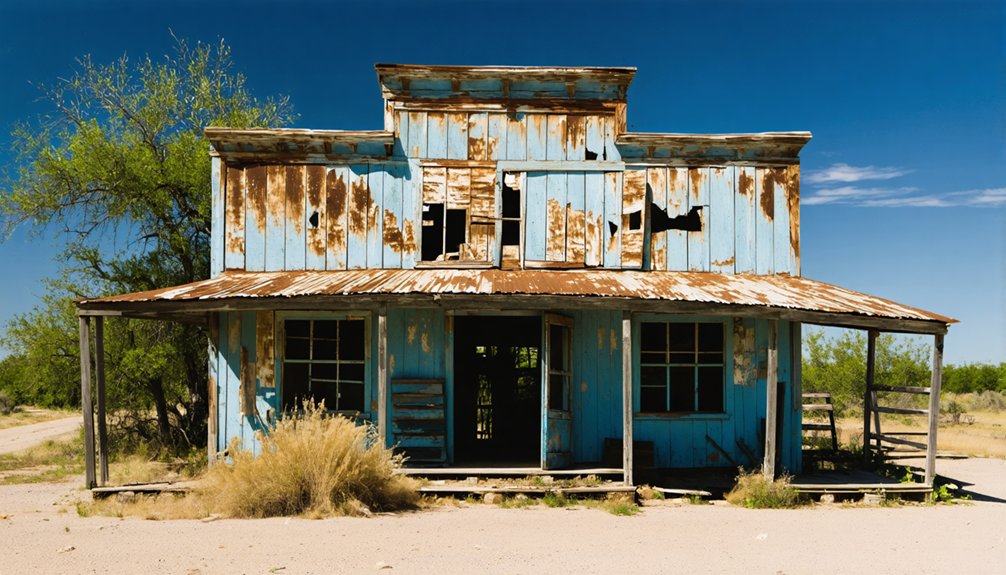You’ll find Park Springs nestled in northwest Wise County, where natural springs once drew settlers and steam locomotives alike. This former boomtown peaked around 1900 with 400 residents, boasting three grocery stores, an eleven-grade school, and a grand 14-room hotel. When diesel engines replaced steam in the 1930s, Park Springs’ essential role as a water stop vanished. Today’s windswept prairie holds countless stories of Texas railroad heritage waiting to be discovered.
Key Takeaways
- Park Springs evolved from a thriving railroad town of 400 residents in 1900 to a ghost town due to transportation changes.
- The town’s decline began when diesel locomotives eliminated the need for water stops from natural springs.
- Rock Island Railroad’s presence initially transformed Park Springs into a boomtown but later contributed to its abandonment.
- The closure of the post office in 1915 and the eleven-grade school in 1944 marked significant milestones in the town’s decline.
- Families migrated to larger cities as railroad jobs diminished, leaving behind empty buildings and a fading community.
From Wilderness to Settlement: The Birth of Park Springs
While many Texas settlements sprang up around railroads, Park Springs got its start thanks to Mother Nature’s own infrastructure – a pristine grove dotted with natural springs in northwest Wise County. You’d have found these life-giving waters nestled in vast uncut forests near the Montague County line, where early settlers recognized the perfect spot to put down roots. Like San Felipe Springs near Del Rio which provided 12 million gallons daily, these natural springs were crucial for sustaining early settlement. In the early 1890s, folks started trickling in, drawn by the fertile soil and abundant natural resources. They first called it Pringle, but Park Springs better captured the essence of this promising place. The town’s establishment was officially marked when the post office opened in July 1893.
The Railroad’s Transformative Impact
You’ll find that Park Springs’ golden age coincided perfectly with the steam locomotive era, when the Rock Island Railroad brought both commerce and settlers to this bustling town of 400 souls.
The railroad’s presence transformed Park Springs from empty prairie into a proper community with stores, hotels, and all the amenities folks needed to build their lives in late 1800s Texas. Much like Palestine, Texas, which saw rapid development when the Houston & Great Northern arrived in 1873, Park Springs flourished with rail connectivity. Like many railways of the time, financial struggles and multiple reorganizations plagued the local rail lines throughout their operational history.
When diesel engines later replaced steam power and highways started competing with rail service, Park Springs’ fortunes changed dramatically – leading to a steady population decline that would eventually turn this once-prosperous rail stop into the quiet place you’ll see today.
Growth During Steam Era
The arrival of the Texas & Pacific Railway mainline sparked a remarkable transformation in Park Springs during the steam era.
As railroad expansion pushed through East Texas, you’d have witnessed steam technology revolutionizing this once-quiet stretch of land. The mighty iron horses brought jobs, commerce, and a steady stream of settlers looking to stake their claim in this promising territory.
You could’ve seen the town come alive with activity as the railroad built essential infrastructure – water towers, repair shops, and telegraph lines dotted the landscape. Powerful locomotives capable of 70 mph speeds thundered through town, connecting communities along the 860-mile route. The 4-4-0 American Standard locomotives became a common sight on the rails, perfectly suited for the region’s passenger and freight needs.
Local businesses flourished near the depot, while farmers and ranchers finally had quick access to distant markets for their goods. The sound of steam whistles echoing across the prairie meant progress, prosperity, and newfound freedom for Park Springs’ ambitious residents.
Diesel’s Impact on Decline
Steam’s golden age gave way to a darker chapter when diesel locomotives rolled onto America’s rails in the 1930s.
While bigger railroads celebrated diesel efficiency, small towns like Park Springs felt the sting of progress. You’d have seen the changes hit our community like a freight train running full steam ahead.
The switch to diesel brought three major blows to Park Springs:
- Traditional railroad jobs vanished as modern engines needed fewer hands.
- Rail companies focused their investments on main lines, leaving our branch line to rust.
- The labor loss rippled through town, shuttering the hotel, stores, and finally our school in ’44.
Like many towns, Park Springs saw its passenger rail service decline sharply after World War II as automobiles became more prevalent.
Watching diesel locomotives replace our steam engines was like watching Park Springs’ heart stop beating, one piston at a time.
The rise of interstate highways in the 1950s delivered another devastating blow to rail-dependent communities across Texas.
A Bustling Community at Its Peak
During its heyday around 1900, Park Springs flourished as a vibrant community of 400 souls, anchored by three bustling grocery stores, a forward-thinking bank, and a prominent 14-room hotel that faced the Rock Island Railroad’s water tower.
A small Texas town’s golden age shone bright, with bustling shops and a grand hotel greeting railroad travelers.
You’d have found yourself right at home in this thriving Texas town, where community gatherings brought folks together for Saturday night square dancing and post-church picnics at the hotel.
The eleven-grade public school provided solid educational opportunities for local youngsters, while two churches – Methodist and Baptist – served as spiritual cornerstones. Like Independence, Texas, which was once the wealthiest community in Texas, Park Springs represented the promise of prosperity in early Texas settlements.
Local entrepreneurs like Seeb Musgrove and Jerry McKay kept commerce humming, with the feed store, ice house, and blacksmith shop meeting everyday needs. Much like the town of Smeltertown, Park Springs would eventually fade into Texas history.
The post office and railroad crew stops kept Park Springs well-connected to the wider world.
Life Around the Fourteen-Room Hotel
Proudly facing the Rock Island railroad line and its towering water tank, Park Springs’ fourteen-room hotel stood as the beating heart of local social life.
You’d find railroad crews mingling with locals, sharing tales and news while enjoying hearty meals in the communal dining room. The hotel’s reputation for hospitality made it the town’s natural gathering spot for community gatherings.
You couldn’t miss these regular events that defined Park Springs’ social calendar:
- Saturday night square dances filled with music and laughter
- Sunday afternoon picnics after church services
- Daily meetups between travelers and townspeople, where stories flowed freely
When steam locomotives needed water stops, you’d see crews making the hotel their home away from home, strengthening those essential railroad connections that kept Park Springs thriving.
Local Businesses and Community Infrastructure

A bustling network of businesses once anchored Park Springs’ daily life, with three grocery stores forming the commercial backbone.
Seeb Musgrove ran the largest grocery operation, while Jerry McKay, John McDonald, and Jimmy James owned other crucial establishments. You’d find everything from a feed store to an ice-house serving your agricultural needs.
The grocery store evolution mirrored the town’s fortunes, supported by essential community services like the local bank and post office.
Margaret C. Evans served as the first postmistress when the office opened in 1893, though it’d close by 1915. The town’s blacksmith kept tools sharp and horses shod, while both Methodist and Baptist churches tended to spiritual needs.
When the eleven-grade school closed in 1944, it marked another step in Park Springs’ gradual decline.
The Beginning of the End: Forces Behind the Decline
You’ll find that Park Springs’ fate was closely tied to the changing ways folks moved around Texas, as improved highways and railways drew traffic away from once-bustling local routes.
Hard-working families who’d built their lives in Park Springs began pulling up stakes, following job prospects to bigger cities where industrial and service jobs beckoned.
When you consider how this migration pattern snowballed, it’s easy to see how each departing household weakened the town’s economic foundation, making it harder for the remaining businesses to stay afloat.
Transportation Changes Impact
While steam locomotives once brought life and prosperity to Park Springs, the shift to diesel engines in the mid-20th century dealt the town its first major blow.
You see, transportation innovations like diesel trains and automobiles sparked a chain reaction of community displacement that’d forever change this once-bustling railroad stop.
Here’s what sealed Park Springs’ fate:
- Diesel locomotives didn’t need those frequent water stops, stripping the town of its strategic importance.
- The rise of automobiles meant folks could easily work in bigger towns like Bridgeport and Decatur.
- Major transportation routes started bypassing Park Springs altogether, favoring other regional hubs.
Y’all can imagine how these changes hit hard – the post office closed in 1915, the school shuttered in ’44, and local businesses couldn’t hold on without the steady stream of railroad traffic.
Economic Migration Patterns
Like a dried-up creek bed in August, Park Springs’ economic significance steadily evaporated as folks sought greener pastures elsewhere during the mid-20th century.
You’d have seen whole families packing up their lives, heading to bustling spots like Bridgeport and Decatur where economic opportunities were as plentiful as bluebonnets in spring.
The community migration hit hard when the post office closed in 1915, and things got tougher when diesel trains meant fewer railroad workers needed to stay in town.
Local fixtures like the ice-house and blacksmith shop couldn’t hold on, and the once-lively hotel grew quiet.
The younger crowd, armed with skills and dreams, naturally drifted toward places that could support their ambitions, leaving Park Springs to slowly fade like an old photograph.
What Remains: A Journey Through Modern Park Springs

As you wander through modern-day Park Springs, you’ll find a haunting stillness where a once-bustling community stood. The abandoned structures tell stories of gradual decline, with deteriorating homes lining what used to be vibrant streets.
That old rusted well hand-pump still stands proud in the center, one of the few historical artifacts reminding us of simpler times.
If you’re fixing to explore what’s left of this Texas ghost town, here’s what you’ll encounter:
- Scattered residential ruins that paint a picture of rural life gone by
- “No trespassing” signs that remind you this ain’t your typical tourist destination
- A handful of occupied homes where stubborn residents still hold their ground
The place sure ain’t what it used to be, with fewer than a dozen folks calling it home nowadays.
Legacy of a Lost Railroad Town
When the Rock Island Railroad rolled into town back in the early 1890s, Park Springs transformed from a tiny settlement into a proper Texas boomtown.
You’d have seen a thriving community of 400 folks, with three grocery stores, a bank, and a bustling hotel that served as the heart of local social life.
But like many railroad towns that dotted the Texas landscape, Park Springs couldn’t survive the changing times.
After World War I, as highways replaced rail lines and transportation patterns shifted, this once-vital stop along the Rock Island route faded into ghost town status.
Today, you’ll find Park Springs’ railroad history preserved through historical associations and local heritage sites, reminding us how the mighty steel rails once shaped the destiny of countless Texas communities.
Frequently Asked Questions
Was Park Springs Ever Connected to Any Significant Historical Events or Figures?
Wonder what made Park Springs tick? You won’t find major historical connections or significant figures here – it’s just your typical Texas railroad town that rose and fell with the rhythms of progress.
What Were the Most Common Occupations of Park Springs Residents?
You’d have found folks mainly working the railroads, tending cattle, and running local trades like blacksmithing. Farming practices kept many busy, while others managed grocery stores and community businesses.
Did Any Famous Travelers or Entertainers Visit the Park Springs Hotel?
Despite 150+ rooms welcoming guests in its heyday, y’all won’t find any famous guests or hotel legends at Park Springs – not a single documented celebrity ever graced those mineral-soaked halls.
Were There Any Notable Crimes or Mysteries in Park Springs History?
You won’t find any documented unsolved disappearances or ghostly sightings in this town’s records. Unlike some Texas ghost towns, Park Springs kept pretty clean when it came to notorious crimes.
Did Native American Tribes Have Settlements Near Park Springs Before Colonization?
You’ll find the Comanche, Tonkawa, and Lipan-Apache all roamed through there, with tribal settlements near water sources. While no exact sites were documented at Park Springs, they’d certainly used those life-giving waters.
References
- https://www.hipcamp.com/journal/camping/texas-ghost-towns/
- https://www.ghosttowns.com/states/tx/pringle.html
- https://dfwurbanwildlife.com/2019/02/26/chris-jacksons-dfw-urban-wildlife/the-wise-county-time-machine/
- https://texashighways.com/travel-news/four-texas-ghost-towns/
- https://www.twtex.com/forums/threads/audubon-on-the-texas-grasslands.34500/
- https://www.southernthing.com/ruins-in-texas-2640914879.html
- https://www.tshaonline.org/handbook/entries/park-springs-tx
- https://en.wikipedia.org/wiki/List_of_ghost_towns_in_Texas
- https://dfwurbanwildlife.com/2011/05/29/chris-jacksons-dfw-urban-wildlife/march-28-2005-ghost-towns-in-north-texas/
- https://www.edwardsaquifer.net/sanfelip.html



